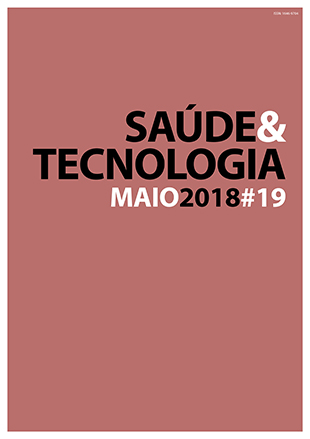Efficacy of music on anxiety control during PET/CT scan
DOI:
https://doi.org/10.25758/set.2171Keywords:
PET/CT with 18F-FDG, Music, Anxiety, Psychophysiological assessment, Patient satisfactionAbstract
Introduction – The control of the anxiety of patients performing positron emission tomography-computed tomography (PET/CT) scans is quite important since this emotional reaction may interfere with the patient’s experience and can even compromise the diagnosis. Music has been used to control patients’ anxiety in several clinical settings. Objective – To verify the efficacy of listening to music in the control of patient's anxiety in PET/CT scans. Methods – Exploratory study where 22 patients were included in the control group (CG) and 23 in the experimental group (EG). Both underwent fluoride-18-labeled fluorodeoxyglucose (18F-FDG) PET/CT scan. The patients included in the EG listened to music during the image acquisition while the ones included in the CG did not. All patients answered scan experience questionnaires as well as a shortened version of the State-Trait Anxiety Inventory-State (STAI-S) questionnaire before the scan (BS) and after the scan (AS). Systolic (SBP) and diastolic (DBP) blood pressure were also measured BS and AS. Results – STAI-S values did not differ significantly between groups both BS and AS. However, from BS to AS, there was an increase in these values in the CG as opposed to a decrease in the EG. Comparing BP in the CG and EG, there were no significant differences in BS but there were significant differences in AS, being values in the EG inferior to the ones in the CG. In the EG, 91.3% of the patients reported that the music is an aid during the scan and the average utility level was 4.4 (0 to 5, 5 the maximum). Conclusions – In the current study, listening to music seems to be effective in the control of patients' anxiety during PET/CT scans, and patients were revealed to be satisfied with this technique.
Downloads
References
Boellaard R, Delgado-Bolton R, Oyen WJ, Giammarile F, Tatsch K, Eschner W, et al. FDG PET/CT: EANM procedure guidelines for tumour imaging: version 2.0. Eur J Nucl Med Mol Imaging. 2015;42(2):328-54.
Hogg P, Testanera G, editors. Principles and practice of PET/CT – Part 1: a technologist’s guide. Vienna: European Association of Nuclear Medicine; 2010. ISBN 978-3-902785-00-8
Aiger M, Palacín M, Pifarré P, Llopart M, Simó M. Effectiveness of relaxation techniques before diagnostic screening of cancer patients. Suma Psicol. 2016;23(2):133-40.
Abreu C, Grilo A, Lucena F, Carolino E. Oncological patient anxiety in imaging studies: the PET/CT example. J Canc Educ. 2017;32(4):820-6.
Elboga U, Elboga G, Can C, Sahin E, Karaoglan H, Kalender E, et al. Assessment of procedure related anxiety and depression in oncologic patients before F-18 FDG PET-CT imaging. J Psychiatry. 2015;18(1):215.
Grilo A, Vieira L, Carolino E, Oliveira C, Pacheco C, Castro M, et al. Anxiety in cancer patients during 18 F-FDG PET/CT low dose: a comparison of anxiety levels before and after imaging studies. Nurs Res Pract. 2017;2017:ID3057495.
Vogel WV, Valdés Olmos RA, Tijs TJ, Gillies MF, van Elswijk G, Vogt J. Intervention to lower anxiety of 18F-FDG PET/CT patients by use of audiovisual imagery during the uptake phase before imaging. J Nucl Med Technol. 2012;40(2):92-8.
Sheldon LK, Swanson S, Dolce A, Marsh K, Summers J. Putting evidence into practice: evidence-based interventions for anxiety. Clin J Oncol Nurs. 2008;12(5):789-97.
Chanda ML, Levitin DJ. The neurochemistry of music. Trends Cogn Sci. 2013;17(4):179-93.
Nilsson U. The anxiety- and pain-reducing effects of music interventions: a systematic review. AORN J. 2008;87(4):780-807.
Buffum MD, Sasso C, Sands LP, Lanier E, Yellen M, Hayes A. A music intervention to reduce anxiety before vascular angiography procedures. J Vasc Nurs. 2006;24(3):68-73.
Lee D, Henderson A, Shum D. The effect of music on preprocedure anxiety in Hong Kong Chinese day patients. J Clin Nurs. 2004;13(3):297-303.
Clark M, Isaacks-Downton G, Wells N, Redlin-Frazier S, Eck C, Hepworth JT, et al. Use of preferred music to reduce emotional distress and symptom activity during radiation therapy. J Music Ther. 2006;43(3):247-65.
Földes Z. The effects of synchronous music on patients undergoing magnetic resonance imaging [Dissertation]. Jyväskylä: University of Jyväskylä; 2016.
Gould van Praag CD, Garfinkel SN, Sparasci O, Mees A, Philippides AO, Ware M, et al. Mind-wandering and alterations to default mode network connectivity when listening to naturalistic versus artificial sounds. Sci Rep. 2017;7:45273.
Marteau TM, Bekker H. The development of a six-item short-form of the state scale of the Spielberger State-Trait Anxiety Inventory (STAI). Br J Clin Psychol. 1992;31(Pt 3):301-6.
van Knippenberg FC, Duivenvoorden HJ, Bonke B, Passchier J. Shortening the State-Trait Anxiety Inventory. J Clin Epidemiol. 1990;43(9):995-1000.
Fioravanti-Bastos AC, Cheniaux E, Landeira-Fernandez J. Development and validation of a short-form version of the Brazilian State-Trait Anxiety Inventory. Psicol Reflexão Crit. 2011;24(3):485-94.
Universidad Complutense de Madrid. Inventario de Ansiedad Estado-Rasgo (State-Trait Anxiety Inventory, STAI) [Internet]. Madrid: Universidad Complutense de Madrid. Available from: https://goo.gl/5Y3ugf
Downloads
Published
Issue
Section
License
Copyright (c) 2022 Saúde e Tecnologia

This work is licensed under a Creative Commons Attribution-NonCommercial-NoDerivatives 4.0 International License.
The journal Saúde & Tecnologia offers immediate free access to its content, following the principle that making scientific knowledge available to the public free of charge provides greater worldwide democratization of knowledge.
The journal Saúde & Tecnologia does not charge authors any submission or article processing charges (APC).
All content is licensed under a Creative Commons CC-BY-NC-ND license. Authors have the right to: reproduce their work in physical or digital form for personal, professional, or teaching use, but not for commercial use (including the sale of the right to access the article); deposit on their website, that of their institution or in a repository an exact copy in electronic format of the article published by Saúde & Tecnologia, provided that reference is made to its publication in Saúde & Tecnologia and its content (including symbols identifying the journal) is not altered; publish in a book of which they are authors or editors the total or partial content of the manuscript, provided that reference is made to its publication in Saúde & Tecnologia.







